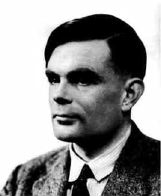

Alan Turing went to Hazlehurst Preparatory School, where he seemed to be an average to good pupil. During a transportation strike, Turing cycled 60 miles each way from
home to school, not too demanding a task for Turing who later was to become a fine athlete of almost Olympic standard.
At Sherborne School he was criticized for his handwriting, struggled at English, and even in mathematics he was too interested with his own ideas to produce solutions to problems
using the methods taught by his teachers. Despite producing unconventional answers, Turing did win almost every possible mathematics prize while at Sherborne. Turing learned some deep mathematics there, although his teachers were probably not aware of the studies he was making on his own. He read Einstein's own papers on relativity and he also read about quantum mechanics from a work of Eddington. In chemistry, a subject which had interested him from a very early age, he carried out experiments which did not please his teacher.
Turing entered King's College, Cambridge in 1931 to study mathematics. In many ways Cambridge was a much easier place for unconventional people like Turing than Sherborne had
been. There he became interested in mathematical logic, and read a paper to the Moral Science Club at Cambridge in 1933.
Turing graduated in 1934, and the following year he attended Newman's advanced course on the foundations of mathematics. This course studied
Gödel's incompleteness results and Hilbert's question on decidability. Turing began to work on proving that for certain propositions were not "decidable". Turing was elected a fellow of King's College, Cambridge in 1935 for a dissertation On the Gaussian Error Function, which independently proved the central limit theorem.
In 1936 he published On Computable Numbers. This paper contains ideas which have proved of fundamental importance to mathematics and to computer science ever since it appeared. It is in this paper that Turing introduced an abstract machine, now called a Turing machine, which moved from one state to another using a precise finite set of rules depending on a single symbol it read from a tape. He defined a computable number as real number whose decimal expansion could be produced by a Turing machine starting with a blank tape. He showed that pi was computable but that most real numbers are not. He also described a number which is not computable and remarks that this seems to be a paradox since he appears to have described in finite terms, a number which cannot be described in finite terms. However, Turing understood the source of the apparent paradox.
Perhaps the most remarkable feature of Turing's work on Turing machines was that he was describing a modern computer before technology had reached the
point where construction was a realistic proposition.
Although to Turing a "computer" was a person who carried out a computation, we must see in his description of a universal Turing machine what we today
think of as a computer with the tape as the program.
Turing became a graduate student at Princeton in 1936 to work with Church, who had also proved that there is no decision procedure for arithmetic. While there, he published several papers on
methods of approximating Lie groups by finite groups and extensions of groups.
Once back at Cambridge in 1938, he starting to build an analog mechanical device to investigate the Riemann Hypothesis, which many consider today the biggest unsolved problem in mathematics.
Soon after his return he was asked to break the German Enigma codes. When war was declared in 1939, Turing immediately moved to work full-time at the Government Code and Cypher School at Bletchley Park. Turing's brilliant ideas in solving codes, and developing computers to assist break them, may have saved more lives of military personnel in the course of the war than any other. Together with Welchman, Turing developed a machine which could decode all the messages sent by the Enigma machines. Turing was awarded the O.B.E. in 1945 for his vital contribution to the war effort.
At the end of the war, Turing was invited by the National Physical Laboratory in London to design a computer. His report proposing the Automatic Computing Engine was submitted in 1946, but there were delays in the project being approved.
In 1948, Turing resigned from the National Physical Laboratory to take up the post of professor of mathematics at the University of Manchester.
In 1950, Turing published Computing Machinery and Intelligence in Mind. It is another remarkable work which studied problems which today lie at the heart of artificial intelligence. It was in this paper that he proposed the Turing Test which is still today the test people apply in attempting to answer whether a computer can be intelligent.
Turing did not forget about questions of decidability which had been the starting point for his brilliant mathematical publications. He proved that there was a cancellative semigroup with
insoluble word problem, and he published this result in 1950. Boone used the ideas from this paper by Turing to prove the existence of a group with insoluble word problem in 1957.
Turing was elected a Fellow of the Royal Society of London in 1951, mainly for his work on Turing machines in 1936. By 1951, he was working on the application of mathematical theory to biological forms. In 1952 he published the first part of his theoretical study of morphogenesis, the development of pattern and form in living organisms. He also worked on new ideas in quantum theory, on the representation of elementary particles by spinors, and on relativity theory.
Turing was arrested and tried for being homosexual in 1952, offering no defense other than that he saw no wrong in his actions. Found guilty he was given the alternatives of prison or estrogen injections for a year. He accepted the latter and returned to a wide range of
academic pursuits. Turing died by eating an apple he had laced with potassium cyanide.